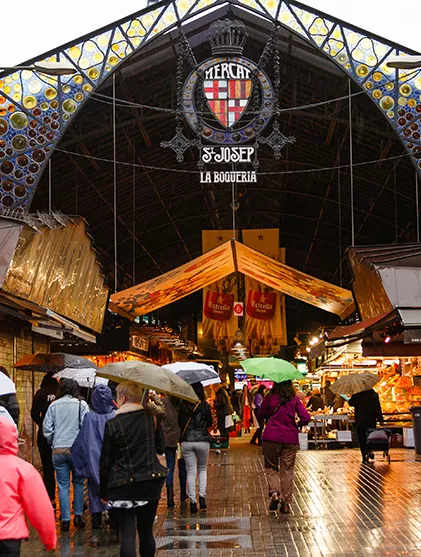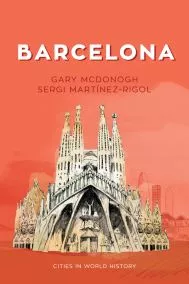Growth and Structure of Cities Chair Gary McDonogh Writes New Book on Barcelona

Growth and Structure of Cities Chair Gary McDonogh has been writing about and researching the city of Barcelona since the 1970s. His latest work on the cradle of Catalan culture is the book Barcelona, for Polity publishing's series Cities in World History. In the interview below, McDonogh talks about the book (co-written with Sergi Martínez-Rigol of the Univeristy of Barcelona), the city, and more.
How did this book come to be?
I have been researching and publishing on Barcelona for 40 years, which motivated Polity to approach me to do it. The project entailed not order and synthesis, but also beginning with learning what was actually available and what was missing in existing guides. I also needed to balance accessible English texts, in tourism, history, cultural studies and literature. Yet core works in Catalan, Castilian, and other European languages have not been translated widely (even less is available from Catalan literature). Working with a younger geographer as coauthor also expanded my links to new generations of Barcelona scholars and the entire academic, literary and artistic milieu there that I wanted to share alongside the city.
This book is written with a general reader/traveler in mind. Was that a challenge giving that you've mostly written for academic audiences?
I think academic authors always wonder who reads our books and why. The challenge here, though, was less the audience than finding the right voice. This was also complicated by coauthoring with someone writing in Spanish who thought in terms of a Barcelona audience. I was glad to have students and colleagues—and my family—as readers and advisors throughout.
What sets Barcelona apart?
The Catalan phrase cap i casal—head and home—sums up the core strengths and tensions in the city that fascinate me. On the one hand, it is clearly a capital—of a past empire, of a nation—but not currently a state—and will be the center of whatever Catalunya becomes. On the other hand, it is cultural home, a place of engagement and creativity (and family dramas). And these roles intersect over time—Roman ruins and medieval palaces flank storefronts now transformed by Chinese and South Asian merchants. Every day I am there, I can walk through a medieval city and a visionary 19th century city and still see the problems of the 21st century and increasingly diverse people’s quests for identity and justice.
Why is Barcelona so special to you personally?
For me, Barcelona really has been the point of interrogation of what cities are (and what interests me about them) for decades. When I first traveled there in college, what attracted me was the individuality and creativity of the city, even under Franco. After studying Catalan as a language and literature, I returned to work in the city in one of its most exciting periods—the transition after Franco when people in all walks of life were imagining new futures and debating them in the streets and bars. Of course, this gave way to the Olympic transformation (which shaped the city for more than a decade) and the demands of becoming a cosmopolitan city as well as national capital, processes that I have both studied and experienced with friends and colleagues. In some ways Barcelona seems like home—my kids have grown up there and there are favorite restaurants we have been patronizing for 40 years. Yet, there is also always a critical distance that emerges from coming and going, from being alien, that pose new questions each time I go back—or when I travel elsewhere or return to the U.S.
What's next for you? Are you writing, planning to teach a new course, planning to travel?
On our sabbaticals next year, my wife and I will focus on finishing our book project on global Chinatowns, with a bit more research in Latin America and Asia (and another trip to Barcelona). And then I am not sure…. Looking back over my career I am seeing the theme of urban memory and erasure urbanism looming large and may find a way to tackle that, again, in Barcelona, where so much has also disappeared since I first saw the city.
Tips for Visiting Barcelona
Where to Stay: Popular tourism has almost overwhelmed the port area and the Ramblas (which nonetheless remain a delightful promenade if not like before). But there are many areas to explore beyond them, tucked into a compact and walkable/bikeable city. Gràcia, for example, was independent of the city until 1898 and maintains the feel of a town within the city, especially when the citizens take over their streets and build fantastic decorations for the celebration of their patronal feast in mid-August. And the Ribera, near the center, links the medieval splendor of Santa Maria del Mar–the cathedral of the sea –with a deep consciousness of national rebellion in the 18th century.
What to See: One has to see Gaudí in context and with time–I never visit Barcelona without allowing time to simply sit and absorb the Park Güell. And one of his most interesting homes, Casa Vicens, has just opened for tourists this year. So much of the city can be absorbed by walking–the layers of the old city in the Barri Gòtic or the baroque project that become the Barceloneta or the proud bourgeois homes along the Rambla de Catalunya and Passeig de Gràcia. That made it easy to write about the city And there are always places to have a coffee and read or just watch the crowds pass by.
Where to Eat: Barcelona has endless restaurants with increasing global variety. But Catalan food begins in the extraordinary market system which has served the city for centuries. The central Boqueria offers exquisite displays of fish and produce but has become overrun with tourists. Smaller neighborhood markets like Santa Caterina or Sant Antoni, Concepció or Llibertat offer gentler pleasures in buying food to cook or checking out the daily specials in the market restaurants.
Off the Beaten Path: Despite my urban bias I like to get out of the city to a smaller Catalan city like modernist Sitges or Villafranca with its heritage of vineyards or Tarragona and the remains of the Roman capital to understand the Catalan foundation of the cosmopolitan capital. Often, there churches or civic buildings or squares that reveal some facet of a history we might overlook in the Barcelona mosaic. There are also festivals or competitions, like castellers, who compete to build multi-story human towers. Villages also have fantastic restaurants that lovingly prepare local specialties with local vintages.
